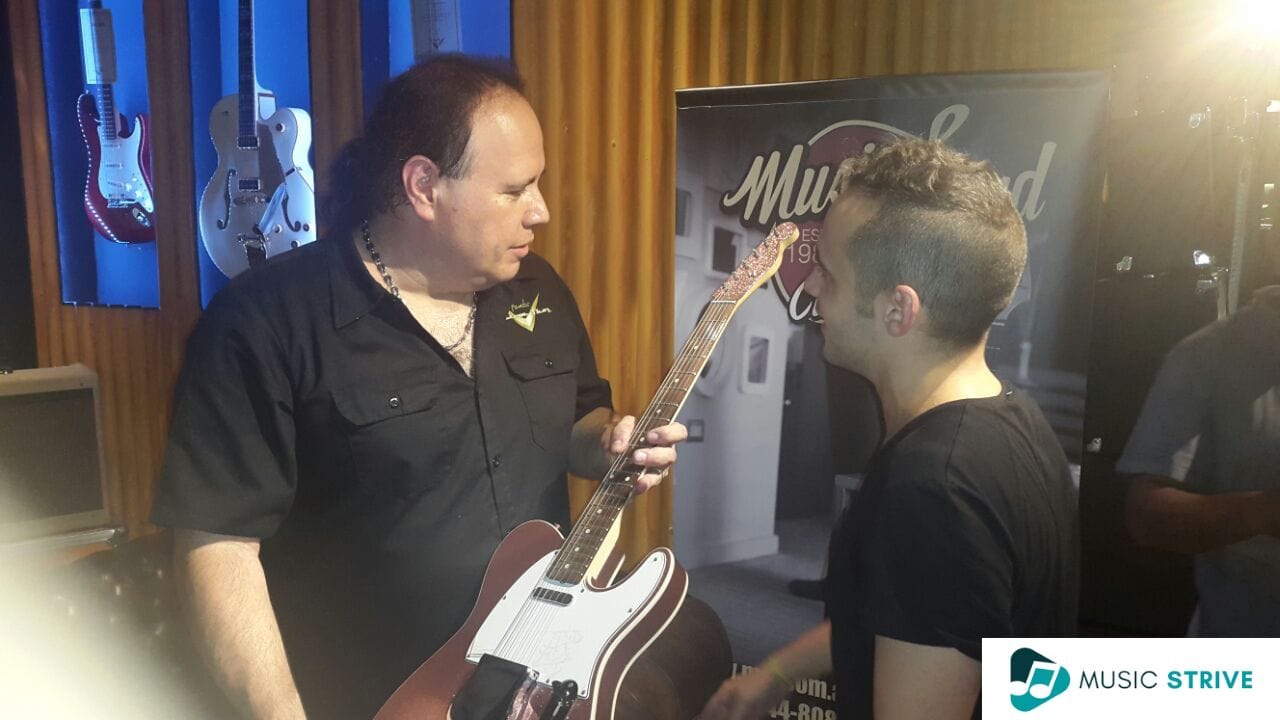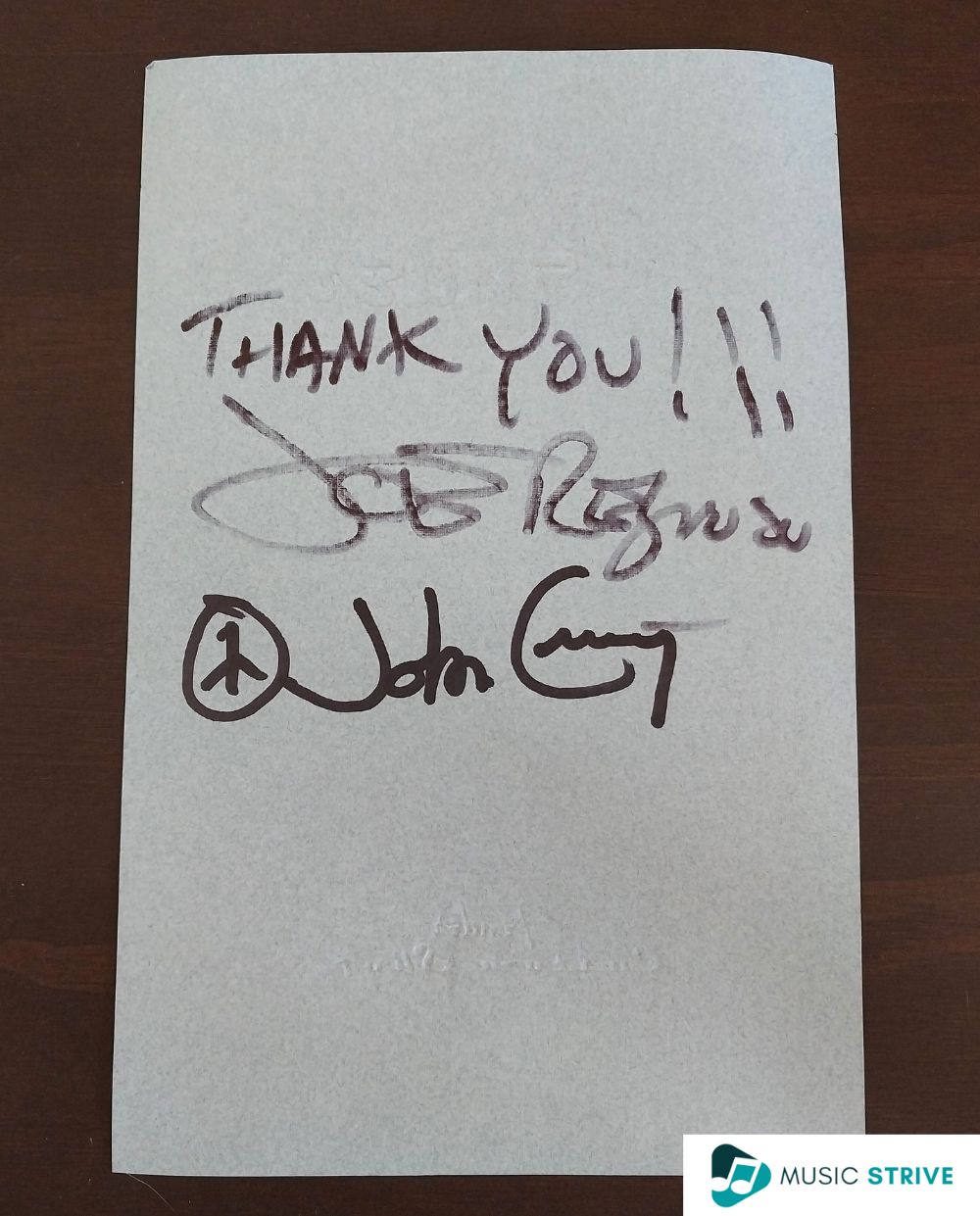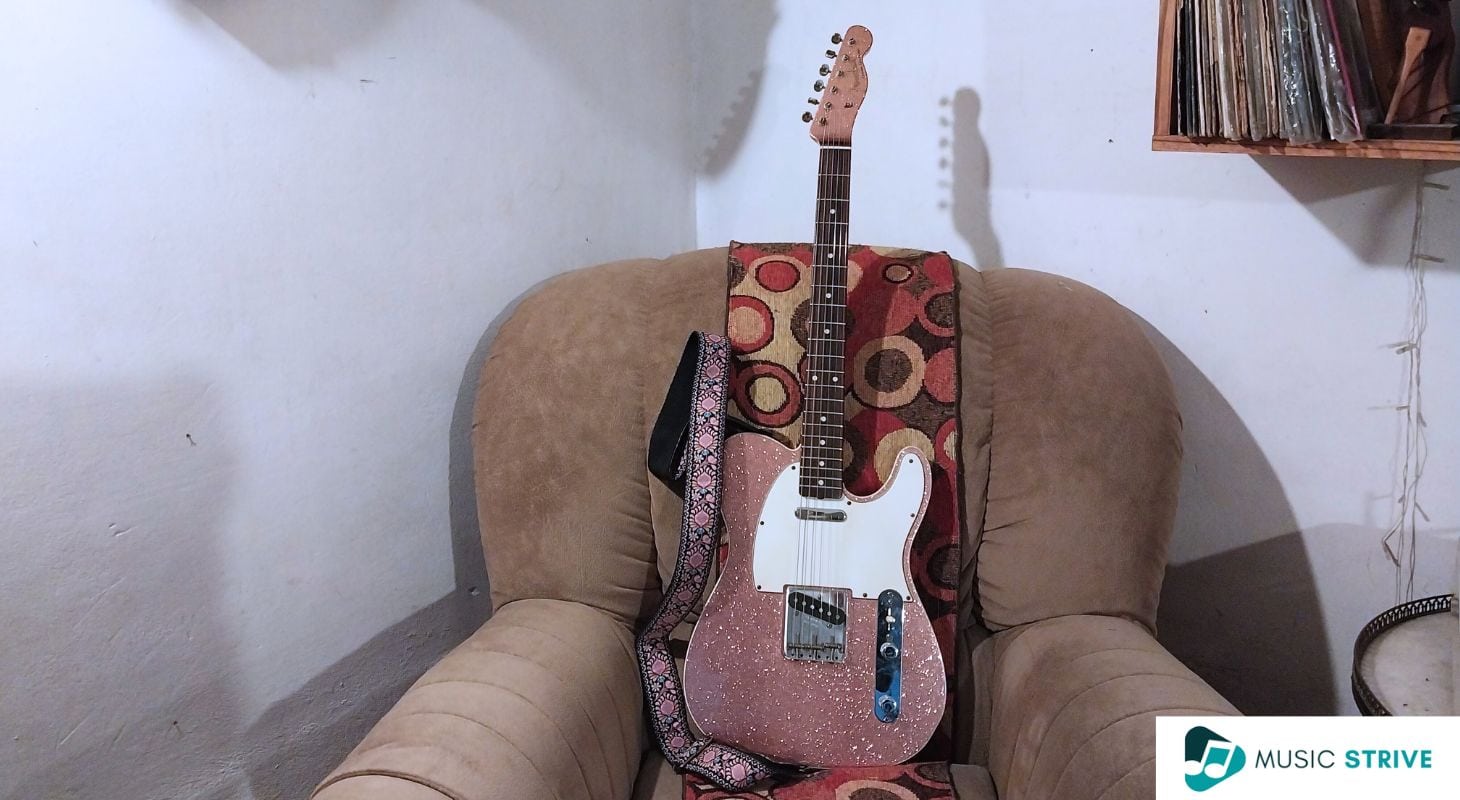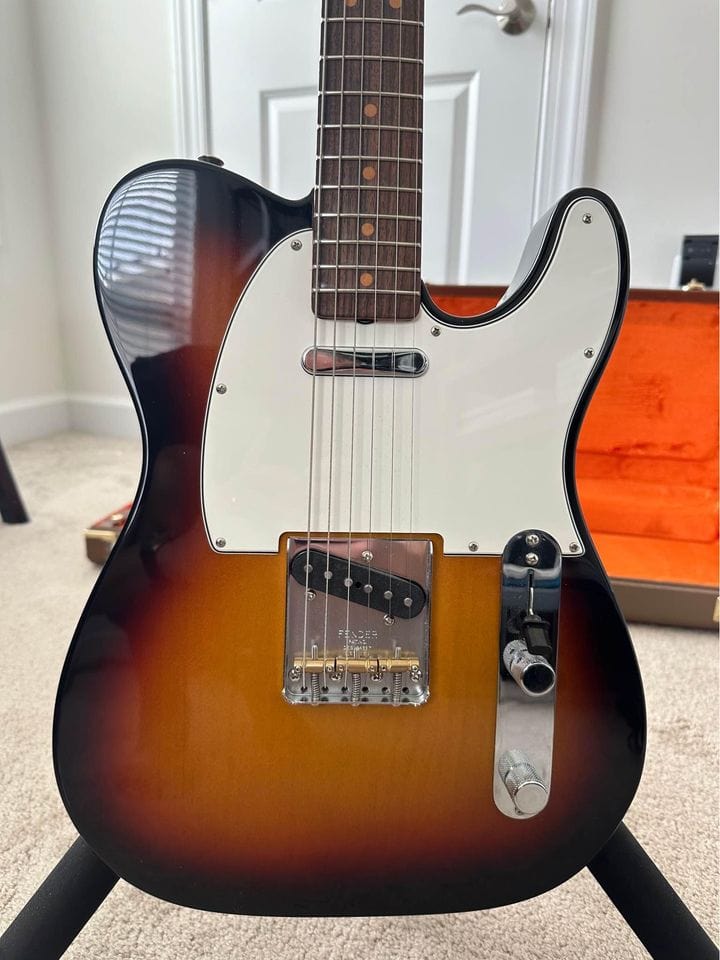I’m not here to answer the question about Fender Custom Shop guitars being overrated instruments or too expensive compared to the factory line of Fender guitars. You’ll find a zillion blog posts that debate whether hype is real, or the guitars are overpriced.
This is not an opinion piece; it’s a piece based on direct experience. You’ll read the words of a guitarist who’s had his Custom Shop instrument for a little over a decade and can tell you what it aged like and what it has given me as a player these years.
I don’t mean to be a spoiler, but I’m more in love with how it sounds, plays, and feels as the years go by. So, if you’re considering a Custom Shop purchase, toying with the idea, and want to know how it feels upon purchase and a decade later, you’re in the right place.
Let’s dive right in, it’s elite-level instrument time.
Table of Contents
What is the Fender Custom Shop?
The Fender Custom Shop can be considered a factory within a factory. It can also be considered the top tier of the Fender legacy and craftsmanship.
I remember organizing a Fender Custom Shop event at the local dealer I worked at some 10 years ago. We had Master Builder John Cruz talking to a crowd gathered to hear him.
I was lucky enough to have ten minutes alone with John as he was setting everything up on stage.

I asked him a question, and his response marked me forever. I said, “Do you know how many guitars you’ve built?” He looked at me, puzzled by my question, and answered, “I don’t have the slightest clue.”
But I’m not the kind of guy who would just drop the topic, so I asked again; “But you’d say within the hundreds, the thousands, or the tens of thousands?”
He looked back at me with a smile and said, “Well, I started sweeping floors and then went through each step of the assembly process before even reaching the Custom Shop. I would say I was involved in, at least, tens of thousands.”
Indeed, John Cruz worked at Fender from 1987 to 2020. He became a Master Builder in 2003, which means it took 16 years of building guitars eight hours a day for him to reach the top tier of the Fender manufacturing line.

Why do I tell you this story? Well, because it illustrates a little about the philosophy behind the Custom Shop and what you can expect from it.
The Custom Shop represents the very best Fender can build. They take the best in each area and move them from the production line to the Custom Shop department. There, they do what they do best all day, every day as a team.
When they excel at each of the tasks, they become Master Builder apprentices and can finally be called Master Builders and work on one-off and limited-run projects.
So, remembering that guitars are instruments that have lots of manual steps in their construction, what you get when you purchase from the Fender Custom Shop is the best of the best in carrying out those manual steps on your guitar.
Are you familiar with the 10,000-hour rule? Well, it applies to each individual working for the Fender Custom Shop.
Entering the Custom Shop Experience Opens a New World
So, what does a Fender Custom Shop instrument feel, sound, play, and age like? I bought my guitar in 2012, and I have played it extensively in and out of the studio since I got it.

It has made records, live performances, and small tours with me, and has also made appearances in friends’ records (because it sounds too good).

The first thing that strikes you when you pick up a Custom Shop guitar (or bass) is that every detail, every corner, everything, as small as it can seem, is taken care of to the point of obsession.
My guitar is a NOS finish (New Old Stock) which means it mimics a guitar that remained inside the box unsold and found 52 years later. It’s a ’60s Telecaster Custom in dazzling champagne sparkle with a matching headstock.

This means it’s a faithful reproduction of a guitar made back in that year to the most obsessive detail. If the design was later improved by Fender, I would get era-correct parts, pieces, and construction.
For example, the pickup selector had a capacitor attached that would make the tone knob go to zero when the neck pickup was selected. I of course had it removed before leaving the shop but that’s just to give you an idea of the level of detail.
The Looks & The Design
I know what you’re thinking… wait a minute, is champagne sparkle an era-correct color for 1960? Well, although Fender was already outsourcing sparkle finish to the automotive industry in 1955, the beauty of the Custom Shop is exactly that: there are no limits. If you want black sparkle on a ’57-spec Strat, you can have it.
For example, you can find something that’s very nice to see but very rare to find that’s the whole color-over-color thing. Back in the day, the factory would make 100 sunburst Strats, for example. Then, a dealer came along and needed 50 Fiesta Red Strats. Well, they just painted the Fiesta Red over the sunburst.
As the paint wore out, the sunburst would start to appear underneath.
And that’s only talking about vintage reissues and era-correct guitars. You can also go bananas on the options and create your own favorite thing. For example, I remember once we got this mahogany-body, ebony fingerboard Cabronita-style guitar with a couple of TV Jones and a Bigsby and it was a rock machine ready to conquer the world.
So, this is another treat of Custom Shop guitars, you can have the best ’57 Stratocaster replica finished in Shell Pink, with a matching headstock, an anodized aluminum gold pickguard, gold hardware, and locking tuners if that’s your thing.

There are no limits as long as you stay within the Fender realm.
In contrast, production line instruments come “as is” and there’s no room for upgrades or changes made as a factory thing, you must overhaul it yourself.
The Feel
The looks and the design are evident as soon as you open the case, but what happens when you take the guitar out of the case and start playing it?
Well, I’ve read and heard a lot about the hype surrounding Custom Shop instruments. There are people saying they’re just souped-up Fender guitars, not better than the ones that come out of the production line.
I disagree with that. I mean, don’t get me wrong, an American Professional Stratocaster is an outstanding guitar for modern players and is one that you can play for a lifetime. Yet, the feel of a Custom Shop is different.
A good analogy is to be sitting in the driver’s seat of a BMW or a Ford. Both cars will take you from point A to point B and share the same principles but feel different.
But the question is why do they feel different? Well, we overlook many times that guitars require lots of manual work and need to be inspected, checked, improved, and finished by discerning humans.
Well, Fender’s most discerning humans work at the Custom Shop. So, what a Custom Shop instrument excels at is the neck shape, contours, and overall feel. In my case, I love Modern-C necks, and, believe me, I can play my Telecaster 4 hours in a row and my hand feels comfortable. The level of consistency achieved by Fender in their Custom Shop instruments is uncanny.
The word is “perfect”.
The Sound
Once you’ve taken the guitar from the case, what do you do first? What I do is put the guitar’s body to my chest and strum a big open chord. It can be an E or a C major. This is something that tells you a lot about the guitar’s build quality.
For example, doing that with a Squier is disheartening because between the thick polyester layer and the multi-piece body, what you get is minimal.
Moving up the Fender line, things get better, and by the time you reach American Vintage II, the guitar truly vibrates under your fingertips.
Well, Custom Shop guitars take that to a whole new level. This is because they’re made with one or two pieces at the most. Furthermore, we’ll talk lines in a bit, but the Artisan line of guitars allows you to play exotic woods in traditional configurations.
I remember picking up the guitar that’s now in my possession for the past decade and feeling it vibrate like a monster putting a smile on my face. You can also have a sorted body, like mine. It means they’ll pick the lightest pieces of alder to make the body and you’ll end up with a very light instrument.
But then comes the time to plug it in and see how it sounds.

The best thing about these guitars from that point of view is the time the company invested in picking the exact pickups it needs to sound at its best. Yes, matching the pickup and the guitar sound is close to an art form, and the Custom Shop is Fender doing it at their best.
But beyond the choice of pickups, some models feature pickups signed by Abigail Ybarra, for example, who was with Fender since 1956 and still hand-winding pickups in the 2000s. She was there to witness all eras of Fender and wounded more than one holy grail pickup in her life.
This is crucial to understanding the value of a Custom Shop instrument. It’s not that they seek perfection, that’s more of a machine work. The people working in the Custom Shop look for that beautiful humanity that all guitars with soul and character have.
Abigail and Josefina don’t make perfect pickups, but they make truly outstanding-sounding pickups with the right amount of dedication and human error to make them unique.
Therefore, what you get when you plug in your Custom Shop instrument is an HD version of the tone in your head. I’ve done it many times working in the shop and the difference between American Vintage and Custom Shop is exactly that, every CS instrument sounds different, special, and unique.
Playability
OK, once plugged in, you strum that big chord and it sounds just like you imagined, then what’s next?
Well, one thing that’s fascinating about the Custom Shop is that the instruments are flawless right out of the box. When you unbox something like a Fender Ultra, what you get is a top-notch instrument you can play in an arena, but it doesn’t come out of the box like that. There’s some fine-tuning involved there.
Custom Shop instruments don’t have dead notes, or buzzing sounds, and stay in tune perfectly. They have been thoroughly tested before being put inside the case for that to happen.
Furthermore, a big thing that’s related to playability is the fretwork and, especially, the neck shape and finish. Well, you might not like the type of neck the guitar sports, but you can’t possibly say that it’s not finished to perfection.
This is especially true when you talk about rolled edges and fret crowns. They’re impeccable from fret 1. Furthermore, if you want to play a beautiful V-neck ’57 Strat but with modern, 6105 fretwire, you can order that straight from the factory.
I would say that playability is one of the biggest points for any CS instrument. They do feel like butter in your hands.
Team-Built Catalog Guitars & Special Orders
Every year, the Custom Shop catalog changes. There are new models coming in, and old models going out, and It’s all divided into categories.
Some categories, like Vintage Custom and Time Machine, recreate the golden era of Fender as it was. Furthermore, the Vintage Custom collection features prototype guitars that barely made it to the light of day. The Time Machine guitars are available with various levels of relic’ing; from NOS to Heavy Relic.
For the most adventurous customers, the Artisan, Limited Edition, Postmodern, and American Custom feature instruments with limited runs that are impossible to find anywhere else on the Fender catalog.
For example, a Custom Telecaster with a factory Bigsby, a CuNiFe neck pickup, and finished in gold sparkle with “rope” binding on the body is part of that catalog. There, you’ll also find exotic woods, modern appointments, and one-of-a-kind instruments.
These guitars are all catalog-ready and team built. This means that the Custom Shop also works as a regular guitar manufacturer, creating guitars they think are cool for customers to buy.
The key is that these guitars are built by the people who emerged from the factory line making American Vintage and American Ultra guitars for being too good at what they do.

Masterbuilt Guitars
After all the tiers of the team-built Custom Shop guitars, what you have is those who emerged from the CS for being just too good. Those are the Master Builders.
They create Masterbuilt guitars from players’ requests and do the whole thing by themselves. For example, John Cruz made the legendary John Mayer Black Nº1, the SRV, and the Yngwie Malmsteen model. These are replicas not even the owners can tell the difference from.
The wait time for them to build you something is, sometimes, up to five years. But you can make sure the guitar you receive is a dream come true. Plus, each of them has a style of their own. It’s the closest thing to ordering a painting from a famous artist, but at a fraction of that price and to play all your life.
For example, in the video below you can see a Fender Jaguar made with a 50,000-year-old piece of wood in the process of petrification. That means the guitar’s wood is becoming stone little by little. But that’s not all, because the inlays are Mastodon tusk that the company just happened to have around.
My Fender Custom Shop Experience (A Decade Later)
What I described above is what happens with Custom Shop instruments upon purchase and before you put the money down for one. Now, it’s time to answer the question about what happens with these instruments as time goes by.
I’ve had my Custom Shop Telecaster for more than 12 years and let me tell you that it has aged beautifully.
Let me divide this into three different aspects, the looks, the feel, and the sound.
The Looks
Custom Shop guitars are painted with Nitrocellulose, a type of paint that is harder to apply, takes more time to dry, but is thinner than polyester paint. It’s the same type of paint used since the ‘50s, therefore, it ensures Custom Shop guitars age like old guitars have.
For example, if you bump a polyester-painted guitar, the finish cracks and comes out in chunks. Nitro, on the other hand, gets beautiful lines when exposed to high and low temperatures rapidly, fades away with the player’s contact, and cracks nicely if you bump it.
My guitar, after the sun and the playing has faded from a stronger pink to somehow an older, faded, more orangey pink. The sparkle, on the other hand, has remained glowing and beautiful so far.
The Feel
This is a more personal category because the feel of a guitar is something unique to each of us. What I can say in this category is that, regardless of the conditions of the stage, the studio, or the tour, I’ve never had a problem with my Telecaster.
Furthermore, I’d say I cleaned the pots for the first time 10 years after buying it and have never had a loose screw or bolt, a crackling jack, or a faulty tuner. Everything feels and works as a solid unit.
Also, something that happened to me with this guitar is that I’ve grown very familiar with the neck and the narrow, vintage frets, which makes it the perfect desert island guitar for me.
The Sound
Have you ever heard the expression “break the guitar in”? Well, it means that guitars take time and playing to get to their sweet spot.
In my experience, that’s about two years after you’ve bought it. This is not something happening only with CS instruments but with all guitars.
The difference between a CS and a regular line-built Fender instrument is that you buy a CS instrument believing that’s the sweet spot and then realize there’s even more tone to be discovered.
I’m not going to lie to you, I’ve played, for example, CS versions of ’51 Nocasters or ’57 Stratocasters that were way too bright for me, but that’s because that’s what that guitar is supposed to sound like.
So, if you like the way a new CS guitar sounds, you’ll love it when it’s broken in. Furthermore, in my experience, I learned where the guitar’s sweet spots are. For example, I love the middle position in my Telecaster and learned that the tone knob halfway up in the bridge position makes stellar creamy lead tones.
Custom Shop guitars and basses get better with time, just like an instrument of that caliber should.
Vintage Original vs. Reissue

Finally, before we wrap this up, I wanted to touch on a topic that’s very important because of price tags. What’s the difference between a vintage original and a Custom Shop instrument?
Well, the difference is gigantic. But that gigantic difference is impossible to navigate. There’s a mid-low frequency that’s there in vintage instruments that you can’t get anywhere else.
I’m lucky enough to own a couple of ‘60s originals, and the richness in the low end isn’t something that you can get in new guitars, not even CS. Yet, those are the guitars that get the closest. Furthermore, they share a musicality that’s far away from harshness and close to sweetness that appears in the high-end that’s beautiful too.
That said, vintage guitars usually don’t play or stay in tune like a CS would. Moreover, they’re not nearly as reliable, and you have to also bear in mind that you’re not only taking a very large sum of money with you on the road, it’s an irreplaceable instrument.
I would say CS guitars are the next best thing after vintage originals, and they’re very close.
The Bottom End
The further you go into your musical journey, the more fine-tuned your ears and hands will get. This means you’ll start dissecting the sound further and might hear stuff you didn’t hear before.
For example, if you grew up playing Squier and Epiphone, the moment you start playing the real thing, you’ll start hearing that harsh treble frequency in the Asian-made Les Pauls and Strats you didn’t hear before.
Well, Fender Custom Shop instruments are the cherry on the cake in terms of musical instruments. You can play an American Professional, American Vintage, or American Ultra for a lifetime and be immensely happy.

The moment you play CS, it’s very difficult to go back to line-built instruments.
Let me finish with a little illustrative story. Working for the Fender dealer we took a used MIJ Fender Telecaster in red sparkle with a factory Bigsby. I said to myself “Amazing backup for the CS tele!”
That was until I plugged both in and the difference in sound, playability, and feel was so big I just put it back in the window and it sold the same day.
Happy (Custom Shop) playing!

The top tier of the Fender legacy is a custom built G&L.
Leo Fender said, “G&L Guitars and Basses are the best instruments I have ever made”.
I reckon Leo would know.